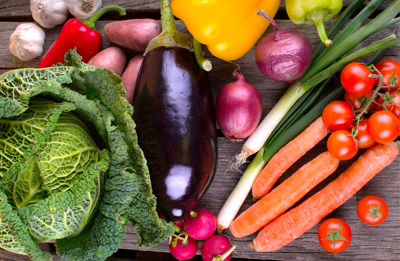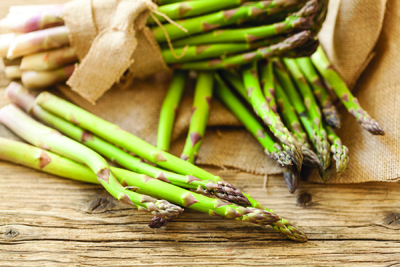Guide E-320
Revised by Nancy C. Flores and Cindy Schlenker Davies
College of Agricultural, Consumer and Environmental Sciences, New Mexico State University
Authors: Respectively, Extension Food Technology Specialist, Department of Extension Family and Consumer Sciences; and County Program Director and Extension Home Economist, Bernalillo County Extension Office, New Mexico State University. (Print friendly PDF)
Introduction
Fresh vegetables can be frozen quickly and easily during the harvest season. Whether you freeze purchased or home-grown vegetables, the keys to a successful product are using vegetables at the peak of ripeness and freezing quickly after purchase or harvest.

(© Petar Vician | Dreamstime.com)
Selection and Purchase
Choose vegetables that are young and tender. Wash well and rinse twice in fresh water to remove dirt. Trim away any damaged spots, tough stems, and leaves. Cut into desired sizes.
Cabbage, cucumbers (unless marinated as a slaw), celery, cress, endive, lettuce, parsley, radishes, and whole potatoes (baked or boiled) do not freeze well.
Freezer Food Safety
Meat, poultry, fish, and eggs must be kept refrigerated at or below 40°F, and frozen food must be kept at or below 0°F. If there is a power failure, maintain cold temperatures of the refrigerator and freezer by keeping doors closed as much as possible. A refrigerator will keep food safely cold for about 4 hours if it is unopened. A full freezer will hold its temperature longer than a half-full freezer for approximately 48 hours if the door remains closed. During a prolonged power outage, use dry ice or block ice. Fifty pounds of dry ice should maintain frozen temperatures for an 18-cubic foot full freezer for 2 days.
Frozen vegetable juices and home and commercially prepared frozen vegetables that have partially thawed can be re-frozen if they contain ice crystals and feel as cold as refrigerated product. Frozen vegetables that have thawed and been held above 40°F for over 2 hours (but less than 6 hours) can be re-frozen, but should be checked for mold, yeasty smell, or sliminess. Discard any questionable product, and do not re-freeze product that was allowed to thaw for more than 6 hours.
Blanching
Although freezing slows the action of ripening enzymes, it doesn’t completely halt it. Blanching is a quick heat treatment to inactivate the ripening enzymes in vegetables. This will help to preserves their color, texture, and flavor for up to 12 months in the freezer.
Except for onions and green peppers, vegetables should be either water or steam blanched before being frozen. Some vegetables, such as mushrooms, eggplant, and summer squash, taste better if sautéed briefly in oil, unsalted butter, or margarine. Chill before packaging, then freeze.
Equipment List
Cutting board and knife
Peeler/corer
Tongs or slotted spoon
Freezer containers or plastic bags
Pot holders x 2
Paper towel roll
Cloth towels x 2
Cooking pot with basket (such as vegetable steamer)
Large strainer in an ice water bath
Accurate timer
Dish soap and scrubber
Steps for Water Blanching
Place the washed, prepared vegetables in a pot of boiling water. Use 1 gallon of water for each pound (about 2 cups) of prepared vegetables. See Table 1 for recommended blanching times for different vegetables. Start timing the blanching action when the water returns to boiling after adding the vegetables. When the blanching time is over, remove vegetables and plunge them immediately into cold (preferably ice) water for the same amount of time that you blanched the vegetables. This cold bath stops the cooking action.
Steps for Steam Blanching
Place 2 cups or about 1 pound of prepared vegetables in a single layer in a steaming basket and lower into a pot containing 1 gallon of boiling water. The vegetables should be above the water. Cover with a tight-fitting lid and start counting the blanching time when steam comes up around the pot lid; see Table 1 for blanching times. Plunge vegetables into an ice water bath.
Microwave Blanching
You can use a microwave oven to blanch small quantities of vegetables. However, there is evidence that his method does not fully inactivate enzymes and could result in poor quality over a prolonged storage time. Additionally, there is no time or money saved when microwave blanching vegetables.
Packing Food Into Freezing Containers
Blanched vegetables should be drained and fully frozen before packing into moisture-proof freezer containers for long-term storage. Blot dry drained vegetable pieces with a clean paper towel to remove surface moisture. Spread out vegetable pieces onto a baking sheet lined with wax or parchment paper and place the baking sheet in the freezer. Once pieces are completely frozen, transfer to labeled bags or containers.
Both freezer bags and square containers can be packed economically to conserve space in the freezer. Fill rigid containers to the expansion line. If you use zippered freezer bags, lay bags on the counter after filling and press out air. Close zipper bags, leaving about 1 inch open, and use a drinking straw to suck air out before closing completely. If using a bag with a twist tie closure, gather the bag edges around a drinking straw and draw out air before twisting and tying.
A vacuum sealer can be used to package frozen vegetables. Closely follow the manufacturer’s operation manual for directions. To prevent botulism poisoning, vacuum-sealed foods must be kept frozen until ready to use and should be cooked thoroughly before consuming.
Use a moisture-proof freezer pen to label containers with packing date and contents. When freezing, place containers in the coldest area of the freezer with about 1 inch around the containers for cold air circulation until the vegetables are frozen. After containers are fully frozen, stack them tightly.
Freeze only the amount of food that the freezer can handle efficiently. A good rule of thumb is 2 to 3 pounds of food for each cubic foot of storage space. Overloading slows the freezing process and adversely affects the vegetables’ quality, especially corn on the cob.
Make a food inventory and post it on the freezer. List the date of freezing, the foods, and number and sizes of containers. Keep a pen close to mark the list as containers are used.
Thawing and Preparing Vegetables To Eat
Except for corn on the cob, vegetables can be cooked with little or no thawing. Corn on the cob should be thawed completely before cooking. Greens should be partially thawed and separated before cooking. Because the vegetables were blanched before freezing, they will cook quickly.
When cooking, use the smallest amount of water possible to conserve nutrients. Cook only the amount you need for the meal. Avoid letting vegetables stand after cooking because nutrients leach into the cooking water.

(© Julia Pfeifer | Dreamstime.com)
|
Table 1. Freezing Techniques for Vegetables |
|||||
|
Vegetable |
Preparation |
Blanching Times and Freezing Techniques |
|||
|
Artichoke hearts |
Remove all leaves, woody stems, and fuzzy portion. Wash hearts in cold water and drain. |
Water blanch 7 min; drain, pack, and seal. |
|||
|
Asparagus |
Wash. Sort by size. Snap off tough ends. Cut stalks into 2-inch lengths or leave whole. |
Water blanch Small: 1 1/2 min |
Steam blanch Small: 2 1/2 min |
||
|
Beans (snap, green, or wax) |
Wash. Trim ends. Cut if desired. |
Water blanch Whole: 3 min |
Steam blanch Whole: 4 min |
||
|
Beets |
Wash. Remove leafy tops, leaving 1 inch of stem. |
Cook until tender, 25–30 minutes for small beets, 45–50 minutes for medium beets. Cool promptly, peel, trim tap root and stem. Cut into slices or cubes. |
|||
|
Broccoli |
Wash. Trim leaves. Cut into pieces. |
Water blanch 3 min |
Steam blanch 3 min |
||
|
Brussels sprouts |
Wash. Remove outer leaves. |
Water blanch 4 min |
Steam blanch 5 min |
||
|
Cabbage |
Wash. Discard coarse outer leaves. |
Water blanch Wedges: 3 min |
Steam blanch Wedges: 4 min |
||
|
Carrots |
Wash, peel, and trim. Cut if desired; leave small carrots whole. |
Water blanch Whole: 5 min |
|||
|
Cauliflower |
Discard leaves and stem. Wash head, then break into florets. |
Add 1 tablespoon vinegar to water. |
|||
|
Water blanch 3 min |
Steam blanch 4 min |
||||
|
Corn, kernels |
Remove husks and silks and trim ends. Wash ears. |
Water blanch medium-sized ears, 3–4 ears at a time, for 4 min. After blanching, cut kernels (about 2/3 depth) from cob, bag kernels, and freeze. |
|||
|
Corn on the cob |
Remove husks and silks and trim ends. Wash ears. |
Water blanch medium-sized ears for 7 min. Cool and drain. Wrap ears individually in plastic wrap. Pack wrapped ears in plastic freezer bags. |
|||
|
Eggplant |
Wash, peel, and slice 1/3 inch thick. |
Water blanch for 4 min in 1 gallon of boiling water containing 1 1/2 tablespoons citric acid or 1/2 cup lemon juice. Alternatively, sauté in oil. |
|||
|
Greens (kale, spinach, etc.) |
Select young, tender greens. Wash. Trim leaves. |
Water blanch 2 min |
Steam blanch 3 min |
||
|
Herbs |
Wash. Snip or leave on stalks. |
For basil only, water or steam blanch 1 min. For other herbs, blanching is not necessary. Freeze in a single layer on baking sheet lined with wax paper; transfer to containers when fully frozen. |
|||
|
Kohlrabi |
Select tender, mature stems. Trim ends and peel off tough bark. Wash. Slice tender centers crosswise, 1/4 inch thick. Leave small roots whole. |
Water blanch slices for 2 min, stems for 3 min. |
|||
|
Mushrooms |
Wipe with damp paper towel. Trim hard tips of stems. Sort by size; cut large mushrooms. |
May be frozen without blanching. Or, blanch whole, 5 min; quarters, 3 1/2 min; slices, 3 min. Or, sauté mushrooms in butter or margarine and cool quickly. |
|||
|
Okra |
Wash. Separate pods 4 inches and shorter from longer pods. Remove stems. |
Water blanch small pods 3 min, large pods 4 min. |
|||
|
Onions, green onions, leeks |
• For onions, remove peel and chop. |
May be frozen without blanching. Bag and freeze. For best odor protection, wrap onions in plastic warp before putting in bags. |
|||
|
Peas, garden/snow/sugar |
Shell garden peas. No need to shell snow or sugar peas. |
Water blanch 1 1/2 min |
Steam blanch 2 1/2 min |
||
|
Peppers, green/red/sweet/hot |
Wash, remove stems and seeds. |
Freeze whole, or cut as desired; no blanching needed. (See NMSU Extension Guide E-311, Freezing Green Chile [http://aces.nmsu.edu/pubs/_e/E311.pdf].) |
|||
|
Potatoes and Jerusalem artichokes |
Wash. Peel, cut, or grate as desired. Either cook in water or sauté grated potatoes in oil. Grated potatoes for hash browns and mashed potatoes freeze well. |
For new potatoes, water blanch whole potatoes 5 min, pieces 2–3 min. |
|||
|
Sweet potatoes |
Wash and dry. |
Bake just until tender, then cool, peel, and cut. Pack in flat layers or roll in lemon juice and brown sugar. Or, purée with orange juice. |
|||
|
Tomatoes, red and green |
Wash and dip in boiling water for 30 seconds to loosen skins. |
Core and peel. Freeze whole or in pieces. Pack into containers. |
|||
|
Winter squash/spaghetti squash/pumpkin |
Wash and remove seeds. |
Bake whole or cut in half. Place cut side down on baking sheet. Cook until tender. Scrape pulp from rind, or remove rind and cube. For pumpkin, cool and cut into cubes, then freeze; or mash pulp, cool, and pack. |
|||
|
Zucchini/summer squash |
Wash, trim ends. Cut into slices or strips. |
Water blanch 3 min or steam blanch 4 min and freeze. Or, cover with breadcrumbs and sauté in oil. Cool and freeze. For sautéed squash, place waxed paper between slices before freezing. |
|||
For more on this topic, see the following publications:
E-508: Keeping Food Safe
https://pubs.nmsu.edu/_e/E508/
E-307: Home Canning of Vegetables
https://pubs.nmsu.edu/_e/E-307/
E-321: Freezing Fruit Basics
https://pubs.nmsu.edu_e/E-321/
|
Original authors: Alice Jane Hendley, Food and Nutrition Specialist. Subsequently revised by Martha Archuleta, Food and Nutrition Specialist. |

Nancy Flores is the Extension Food Technology Specialist in the Department of Extension Family and Consumer Sciences at NMSU. She earned her B.S. at NMSU, M.S. at the University of Missouri, and Ph.D. at Kansas State. Her Extension activities focus on food safety, food processing, and food technology.

Cindy Schlenker Davies is the County Program Director and Extension Home Economist at NMSU’s Bernalillo County Extension Office. She earned her B.S. at Eastern New Mexico University and her M.A. at NMSU. Her Extension and public outreach work focuses on food processing and preservation and food safety.
To find more resources for your business, home, or family, visit the College of Agricultural, Consumer and Environmental Sciences on the World Wide Web at pubs.nmsu.edu
Contents of publications may be freely reproduced for educational purposes. All other rights reserved. For permission to use publications for other purposes, contact pubs@nmsu.edu or the authors listed on the publication.
New Mexico State University is an equal opportunity/affirmative action employer and educator. NMSU and the U.S. Department of Agriculture cooperating.
Revised August 2015


